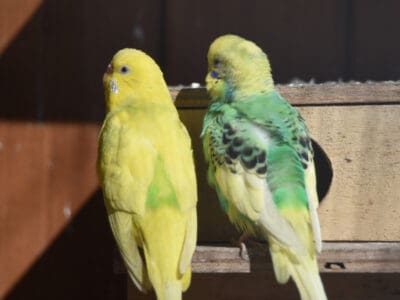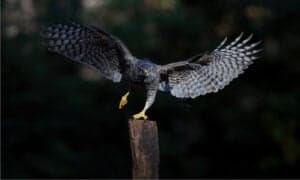Male vs Female Great Blue Heron: What Are The Differences?
Great blue herons are large wading birds that live in freshwater wetland habitats across North and Central America. In fact, as the largest herons native to North America, they are well known for their distinctive long-legged and long-necked appearance. With their stunning greyish-blue plumage, they are easy to recognize. But one thing that can be quite tricky is telling the difference between males and females. Although they both look incredibly similar, there are a few subtle differences that make distinguishing the two a little easier. So join us as we take a closer look at great blue heron males vs females!
Comparing Male vs Female Great Blue Heron
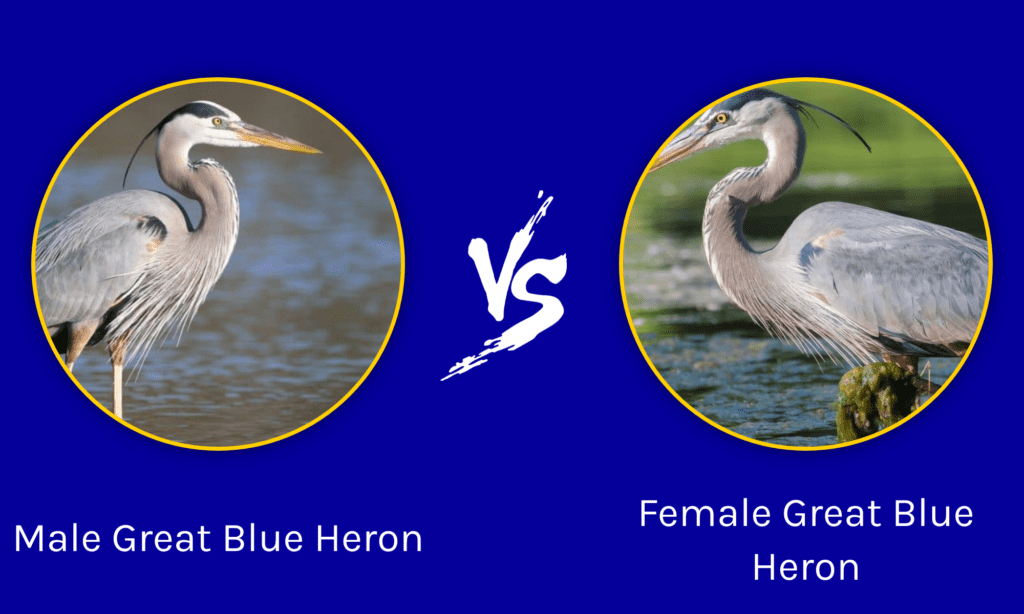
A-Z-Animals.com
| Male | Female | |
|---|---|---|
| Size | 6 to 8 pounds Up to 54 inches long |
4.5 to 6 pounds 34 to 40 inches long |
| Juvenile Appearance | Develop white feathers on head before females. Legs turn bright orange at beginning of breeding season | Develop white feathers on head later than males. Legs remain grey at beginning of breeding season |
| Mating Behavior | Fly in large circles above the nesting grounds while calling loudly. Fight off other males for their chosen female | Remain in one place while calling to the males |
| Nesting Behavior | Choose the nest site and bring nesting materials to the female | Builds the nest using the materials the male provides for her |
The 4 Key Differences Between Male and Female Great Blue Heron
The key differences between male and female great blue herons are size, nesting behavior, juvenile appearance and mating behavior.
Let’s explore them in details below.
Male vs Female Great Blue Heron: Size
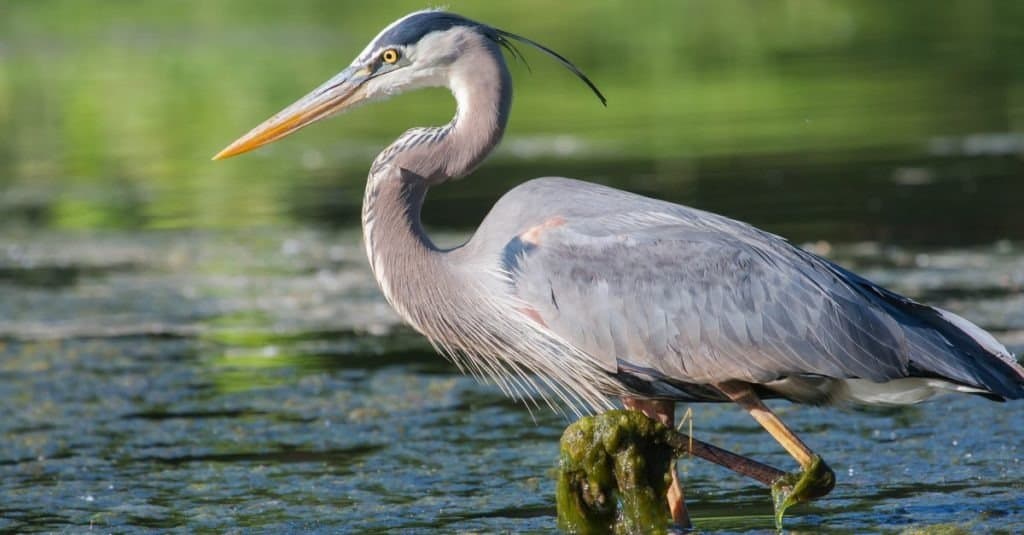
Joseph Scott Photography/Shutterstock.com
Great blue herons exhibit sexual dimorphism, which means that different sexes of the same species are of different sizes. In this case, male great blue herons are larger than the females. Females tend to weigh between 4.5 and 6 pounds while males are heavier than them at 6 to 8 pounds. Males are also longer than females and are up to 54 inches long, while females are approximately 36 to 40 inches. The size of their bills also differs too – with males having a slightly longer bill than females.
Male vs Female Great Blue Heron: Juvenile Appearance
Great blue herons aren’t fully mature until they are three years old. Juvenile males and females have different appearances as they are maturing, which makes them easier to tell apart. Juveniles are generally a much duller color than adults – they have a blackish-grey crown, less defined markings on the flanks, and a greyish-yellow bill. During their first spring, males develop the white feathers on their heads and the black plumes on their crest before the females do. Additionally, at the start of their third year (at sexual maturity), the male’s legs turn bright orange at the beginning of the breeding season while the female’s legs remain grey.
Male vs Female Great Blue Heron: Mating Behavior
One of the most important aspects of a great blue heron’s life – and to the survival of the species – is the choosing of a mate. Unlike many other birds, great blue herons do not mate for life. Instead, they form a monogamous pair that remains together for the breeding season and then choose new mates the following year. To choose a mate, great blue herons undertake a courtship ritual. However, the roles of the males and females are very different.
Great blue herons nest in large colonies, and the males usually arrive at the nesting grounds before the females in order to choose a suitable nest location. They then fly in huge circles above the nesting grounds while calling to the females in an attempt to woo them. During this circular flight, the males tend to use extremely slow beats of their wings and fly with their necks extended fully out. Fights often break out between the males as they fight for the attention of the females, but these fights are rarely ever fatal. While the males are doing their utmost to show themselves off as the most suitable mate, females sit in one spot and call to them until the right mate presents himself.
Male vs Female Great Blue Heron: Nesting Behavior
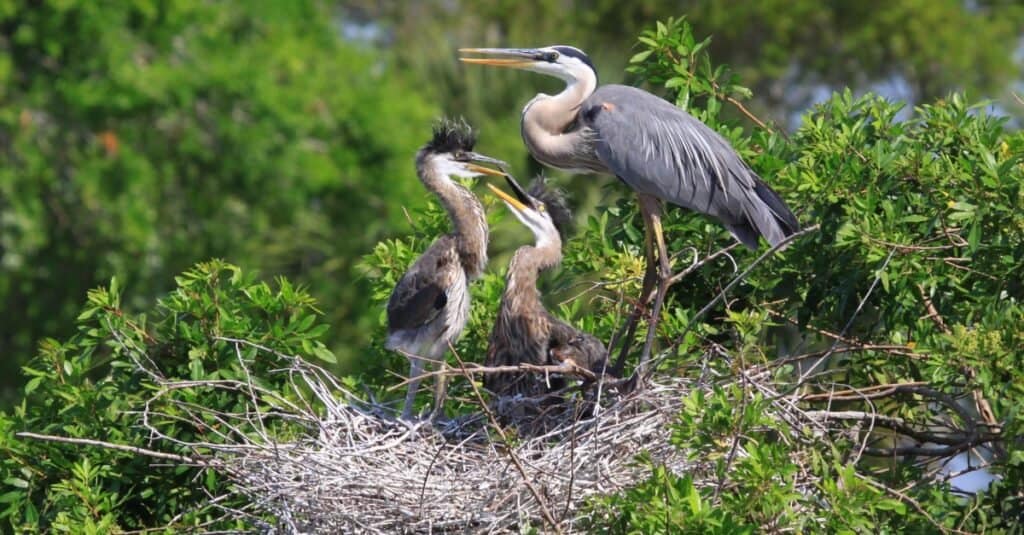
Wolf Mountain Images/Shutterstock.com
Just like during the courtship ritual, the roles of the males and females during the nesting process are very different. As we’ve just mentioned above, the males tend to choose the nest site before the females arrive at the nesting grounds. Sometimes he chooses an entirely new location for a nest to be built from scratch, or other times he selects an old nest. Once the male and female have successfully bonded, the male then selects the materials needed to build the nest and brings them to the female. Quite often, they present the twigs and leaves to the female with a bit of a performance. This includes dropping them in front of her while shrieking (and feeling quite proud of himself!)
Once the male provides the female with the materials needed, it is the turn of the female. The female great blue herons take sole responsibility for building the nest (or repairing it if it’s an old one). Nests can take up to a week to build, which isn’t surprising as they’re pretty large! Great blue heron nests are usually around 2 feet wide when they are first built but can eventually end up approximately 3 feet wide and 3 feet deep. Nests are built out of twigs but then lined with leaves, moss, and other plant materials.
The females lay up to 6 eggs, and the incubation duties are shared by both parents. The eggs take around 25-30 days to hatch, although they don’t all hatch at the same time. Instead, they hatch over a period of several days, with the first chick born being the strongest. The first born also grows the fastest and is the most aggressive in the food.
FAQs (Frequently Asked Questions)
Do both males and females rear the chicks?
Yes, both parents feed the chicks by regurgitating food for them. The parents eat around four times more food than usual when they are rearing chicks so that they have enough to feed them all.
More from A-Z Animals
Great blue herons are large wading birds that live in freshwater wetland habitats across North and Central America. In fact, as the largest herons native to North America, they are well known for their distinctive long-legged and long-necked appearance. With their stunning greyish-blue plumage, they are easy to recognize. But one thing that can be quite tricky is telling the difference between males and females. Although they both look incredibly similar, there are a few subtle differences that make distinguishing the two a little easier. So join us as we take a closer look at great blue heron males vs females!
Comparing Male vs Female Great Blue Heron

A-Z-Animals.com
| Male | Female | |
|---|---|---|
| Size | 6 to 8 pounds Up to 54 inches long |
4.5 to 6 pounds 34 to 40 inches long |
| Juvenile Appearance | Develop white feathers on head before females. Legs turn bright orange at beginning of breeding season | Develop white feathers on head later than males. Legs remain grey at beginning of breeding season |
| Mating Behavior | Fly in large circles above the nesting grounds while calling loudly. Fight off other males for their chosen female | Remain in one place while calling to the males |
| Nesting Behavior | Choose the nest site and bring nesting materials to the female | Builds the nest using the materials the male provides for her |
The 4 Key Differences Between Male and Female Great Blue Heron
The key differences between male and female great blue herons are size, nesting behavior, juvenile appearance and mating behavior.
Let’s explore them in details below.
Male vs Female Great Blue Heron: Size

Joseph Scott Photography/Shutterstock.com
Great blue herons exhibit sexual dimorphism, which means that different sexes of the same species are of different sizes. In this case, male great blue herons are larger than the females. Females tend to weigh between 4.5 and 6 pounds while males are heavier than them at 6 to 8 pounds. Males are also longer than females and are up to 54 inches long, while females are approximately 36 to 40 inches. The size of their bills also differs too – with males having a slightly longer bill than females.
Male vs Female Great Blue Heron: Juvenile Appearance
Great blue herons aren’t fully mature until they are three years old. Juvenile males and females have different appearances as they are maturing, which makes them easier to tell apart. Juveniles are generally a much duller color than adults – they have a blackish-grey crown, less defined markings on the flanks, and a greyish-yellow bill. During their first spring, males develop the white feathers on their heads and the black plumes on their crest before the females do. Additionally, at the start of their third year (at sexual maturity), the male’s legs turn bright orange at the beginning of the breeding season while the female’s legs remain grey.
Male vs Female Great Blue Heron: Mating Behavior
One of the most important aspects of a great blue heron’s life – and to the survival of the species – is the choosing of a mate. Unlike many other birds, great blue herons do not mate for life. Instead, they form a monogamous pair that remains together for the breeding season and then choose new mates the following year. To choose a mate, great blue herons undertake a courtship ritual. However, the roles of the males and females are very different.
Great blue herons nest in large colonies, and the males usually arrive at the nesting grounds before the females in order to choose a suitable nest location. They then fly in huge circles above the nesting grounds while calling to the females in an attempt to woo them. During this circular flight, the males tend to use extremely slow beats of their wings and fly with their necks extended fully out. Fights often break out between the males as they fight for the attention of the females, but these fights are rarely ever fatal. While the males are doing their utmost to show themselves off as the most suitable mate, females sit in one spot and call to them until the right mate presents himself.
Male vs Female Great Blue Heron: Nesting Behavior

Wolf Mountain Images/Shutterstock.com
Just like during the courtship ritual, the roles of the males and females during the nesting process are very different. As we’ve just mentioned above, the males tend to choose the nest site before the females arrive at the nesting grounds. Sometimes he chooses an entirely new location for a nest to be built from scratch, or other times he selects an old nest. Once the male and female have successfully bonded, the male then selects the materials needed to build the nest and brings them to the female. Quite often, they present the twigs and leaves to the female with a bit of a performance. This includes dropping them in front of her while shrieking (and feeling quite proud of himself!)
Once the male provides the female with the materials needed, it is the turn of the female. The female great blue herons take sole responsibility for building the nest (or repairing it if it’s an old one). Nests can take up to a week to build, which isn’t surprising as they’re pretty large! Great blue heron nests are usually around 2 feet wide when they are first built but can eventually end up approximately 3 feet wide and 3 feet deep. Nests are built out of twigs but then lined with leaves, moss, and other plant materials.
The females lay up to 6 eggs, and the incubation duties are shared by both parents. The eggs take around 25-30 days to hatch, although they don’t all hatch at the same time. Instead, they hatch over a period of several days, with the first chick born being the strongest. The first born also grows the fastest and is the most aggressive in the food.

